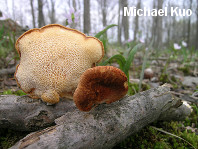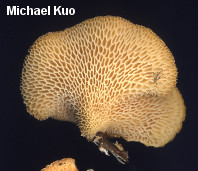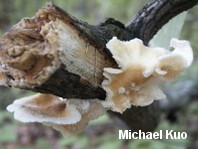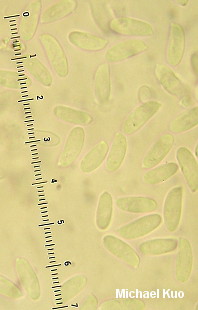| Major Groups > Polypores > Stemmed, Pale-Fleshed > Neofavolus alveolaris |

|
Neofavolus alveolaris [ Basidiomycota > Polyporales > Polyporaceae > Neofavolus . . . ] by Michael Kuo This small polypore appears in the spring, during morel season, on hardwood sticks. Its orange cap and diamond-shaped to hexagonal pores make it an easy species to recognize. Long after the morels have disappeared, however, Neofavolus alveolaris is still hanging around--and its tough little fruiting bodies often persist through the summer and into the fall, fading to nearly white as the seasons progress. There has always been confusion regarding the proper name for this mushroom; it has been placed in Polyporus and Favolus, among other genera. The most recent study (Sotome et al., 2013), however, erects the new genus Neofavolus for our little orange friend and its close relatives (all from Asia) on the basis of molecular and morphological evidence. I don't particularly agree with the authors' decision; the molecular support, which can be seen in any of the cladograms in Sotome and collaborators, 2008, lends itself equally to labeling what the authors call Clades 1 though 5 as Polyporus, which would be a much more simple proposition involving fewer new names. Favolus alveolaris, Polyporus alveolaris, and Polyporus mori are synonyms. The name Neofavolus alveolaris, which I am using here, may be officially invalid, following a very minor mistake made by Sotome and collaborators, 2013 (they cited the wrong MycoBank number for the species in their publication); whether this nomenclatural problem has been officially cleared up or not is unclear to me. Description: Ecology: Saprobic on recently-dead sticks and small logs (occasionally on living branches) of hardwoods, when bark is still attached; causing a white rot; growing alone, scattered, or gregariously; typically first appearing in late spring, but frequently found in summer and fall; widely distributed and common east of the Rocky Mountains. The illustrated and described collections are from Illinois and Québec. Fruiting Body: 2-7 cm across; fan-shaped, semicircular, or kidney shaped; upper surface orange to orangish when fresh and young, fading with age to yellowish or nearly white, radially fibrillose to scaly (at least at first), dry, bald; typically featuring a short and stubby lateral stem, but occasionally with a centrally located and more substantial stem (in which case the cap is round, rather than kidney shaped); pore surface descending the stem, whitish to pale orangish; pores to 1 mm wide and 2 mm long, diamond-shaped or "honeycombed," usually radially arranged; flesh to 2 mm thick, white, tough, unchanging when sliced. Odor and Taste: Odor not distinctive; taste not distinctive, or slightly bitter. Chemical Reactions: KOH dull olive on fresh cap; negative on flesh. Spore Print: White. Microscopic Features: Spores 8-14 x 2.5-4 µ; subcylindric; smooth; hyaline in KOH. Basidia 4-spored. Pileipellis a cutis of somewhat agglutinated, hyaline to brownish, clamped elements 2-3 µ wide. Hyphal system dimitic. REFERENCES: (De Candolle 1815) Sotome & T. Hattori, 2013. (Fries, 1821; Overholts, 1953; Smith, Smith, Weber, 1981; Arora, 1986; Gilbertson & Ryvarden, 1987; Phillips, 1991/2005; Lincoff, 1992; Horn, Kay & Abel, 1993; Barron, 1999; Roody, 2003; McNeil, 2006; Miller & Miller, 2006; Binion et al., 2008; Sotome et al., 2008; Sotome et al., 2013; Kuo & Methven, 2014.) Herb. Kuo 05029502, 05099502, 04200303, 05060605, 04270705, 04220801. This site contains no information about the edibility or toxicity of mushrooms. |
© MushroomExpert.Com |
|
Cite this page as: Kuo, M. (2015, March). Neofavolus alveolaris. Retrieved from the MushroomExpert.Com Web site: http://www.mushroomexpert.com/neofavolus_alveolaris.html |






